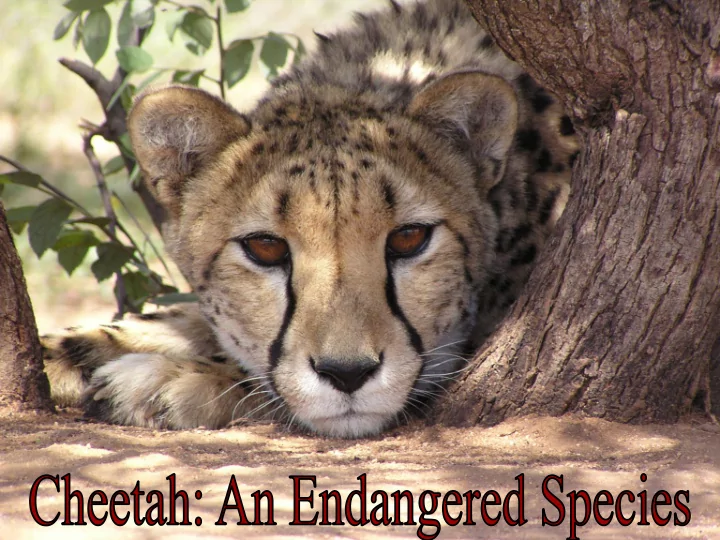

In a 5,000 Year History With Humans, cheetahs were… Revered by royalty Worshipped as symbols of speed Used as hunting animals in the sport of coursing
The cheetah is uniquely adapted for speed Shoulder Blades not attached Pivoting hip bones Flexible Spine Long, heavy tail Small, streamlined head Light skeleton Semi-retractable claws Grooves on pads for traction Long leg bones Enlarged heart, increased lung capacity
Just how fast are cheetahs? The cheetah is the fastest land mammal It can only maintain its speed for 400- on earth and can easily outrun the fastest 500 meters before it overheats and will human sprinter. have to rest for up to 30 minutes. It can reach speeds of up to 110 km/hr It can go from 0 to 80 km/hr in 3 seconds (about 70 mph) in seconds. (a Ferrari needs 4 seconds!). At full speed, its stride is over 7m (or 23 feet)! For half of its stride, no feet are on the ground.
The Cheetah’s Challenges • 1- Conflict with larger predators in protected game reserves • 2- Conflict with humans over livestock • 3- Destruction of habitat and prey base • 4- Low genetic variability
Cheetah Conservation Fund International Research and Education Center, Founded by Dr. Laurie Marker in 1990, the Cheetah Conservation Fund (CCF) international non-profit - based in Namibia “We see a world in which cheetahs live and flourish in co -existence with people and the environment.” ( CCF Vision Statement)
1- Conflict with larger predators in protected game reserves Cheetahs are built for speed, not power. This makes it easy for other large predators such as lions, leopards, and hyenas to steal their kills. Because game reserves have many other large predators, cheetahs are pushed out. 95% of all cheetahs live on farmland. This puts them in direct contact with humans!
2- Co Conf nfli lict t wi with hum h human ans- CC CCF Mo Mode del l Far arm Reduc ucing ing conf nflict lict – Al Altern rnative ative Li Liveli lihoo hoods
Tr Trai ainin ing g Pro rogr gram am (p (para ara-vet) vet) HOOF MAINTENANCE VACCINATIONS RECORD KEEPING PROTECTION FROM PREDATORS PRODUCTION = $
Conservation – Guard dogs breeding The Anatolian Shepherd is originally from Turkey and has been used as a guard dog for livestock for over 6,000 years Guard dogs will bond with the livestock and protect them from predators.
Va Valu lue e Add dded ed to to Liv ivestock estock Production duction CCF is teaching how to make cheese, yogurt, and fudge 900 liters of milk per goat per year!
3- Habitat Destruction - Poor or farmin rming g practices actices chan ange ge habitats itats Habitat restoration program Overgrazing by livestock turns the savannah from normal grassland perfect for cheetahs to dense bush like below. Why do you think cheetahs have a difficult time in this new environment? A cheetah who has tried to run through the dense bush
CCF’s Habitat Restoration Program ECOLOGICAL How can we restore Habitat? Harvest vest 3000 tons/yr s/yr 2008 Intel Environmental Awards . 2010 Tyler Prize for the SOCIAL Environment. ECONOMIC How can the local community derive Biomass Electricity How can we pay for benefits from habitat restoration? natural resources? >40 jobs
4- Genetic Research and Ecological Research
Research - cheetah health and reproduction Genetic Problems The Genetic Bottleneck After the last ice age 10,000 years ago, most cheetahs throughout the world disappeared. Only a very small population in southern Africa survived. With such a drastic reduction in numbers, close relatives were forced to breed and the cheetah became genetically inbred meaning all cheetahs are closely related. In most species, related individuals share about 80% of the same genes. With cheetahs, this figure rises to about 99%. This lack of genetic variability has led to a large number of animals dying at birth, poor sperm quality, and greater susceptibility to disease. Genetic variability is essential for a species to survive!
Ecolo logical gical Researc search • Cheetah ecology • Surveying techniques • Prey and habitat studies Scat Detection Dogs Radio telemetry Camera trapping
6- Education – school children Education is the key to saving the wild cheetah. At CCF we educate everyone we can including school children, teachers, local farmers, politicians, university students, and tourists.
The race is on and its up to us to save the cheetah
www.guepard.info 4 jours au CCF https://www.youtube.com/user/ccfcheetah/videos Please help us save the wild cheetah www.cheetah.org
Recommend
More recommend